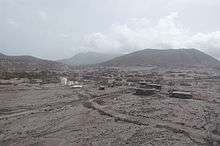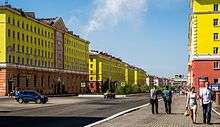Exclusion zones
An exclusion zone is established by a sanctioning body to prohibit specific activities in a specific geographic area for control of populations for safety, crowd control, or military purposes; these differ from other next-to-impossible destinations in that a government is explicitly prohibiting visitors instead of simply providing no infrastructure.
Environmental disasters
In Montserrat

- Soufrière Hills Volcano Exclusion Zone. The capital was built at the base of a volcano that was dormant for hundreds of years. That changed in the 1990s, and the southern half of the island had to be evacuated.
Military
War zones tend to be dangerous or impassible for travel; there are also exclusion zones around a few key or remote military bases.
Military bases
In the United States of America
- Area 51, a US Air Force base which tests prototype war planes, is legendary for a high level of military secrecy and therefore accepts no visitors.
Demilitarised zones
_-_Magusa_(Famagusta)_-_Turkish_Republic_of_Northern_Cyprus_(28600579306).jpg)
Various demilitarised zones have been established as areas of reduced military presence on the border between two states in the aftermath of armed conflict.
- The Korean demilitarised zone is best known; a similar zone once existed on the North-South Vietnam border.
Entire ghost towns have been created by military conflict; in rare cases these are abandoned as military exclusion zones:
- Varosha (near Famagusta, Cyprus) has been abandoned since the 1974 Turkish occupation of Northern Cyprus and heavily-armed Turkish soldiers prevent visitors from entering or taking photographs of the crumbling seaside resort town.
Closed cities

During the Soviet Union tens of cities were designated as closed cities, which in practice meant that you would need an authorization to enter them and they weren't marked on any non-classified maps. These cities were sites of sensitive industry and research and they were often quite large (hundreds of thousands of inhabitants). Some of those cities, like Norilsk, are still closed.
There were also secret cities in the Manhattan Project era, entire populated places secretly constructed in remote or desert locations to serve the war effort. Oak Ridge (Tennessee) and Los Alamos (New Mexico) were among these planned communities.
Local or political restrictions
Border zones
- In Cold War Europe, a 5 km (3.1 mi) exclusion zone applied to much of the East German (GDR) side of the Iron Curtain; access was strictly regulated, so a few German villages historically within this zone were demolished or became ghost towns.
- A Border Security Zone still exists at many points in Russia, mostly on external borders where economic activity and access are restricted under the Frontier Regime Regulations of the FSB (Federal Security Service). Foreign tourists need a permit from the local FSB department to visit the zone.
Conservation
- There are still a few isolated human settlements which contain uncontacted peoples or native groups which do not wish to have contact with outsiders. For instance, it is illegal to visit North Sentinel Island in the Andaman and Nicobar Islands in order to protect the indigenous Sentinelese tribe.
- Some wildlife sanctuaries contain parkland with no road or overland access to protect migratory birds or other fauna; these are closed to the casual visitor and provide only a very limited, regulated access under strict oversight to scientific researchers.
